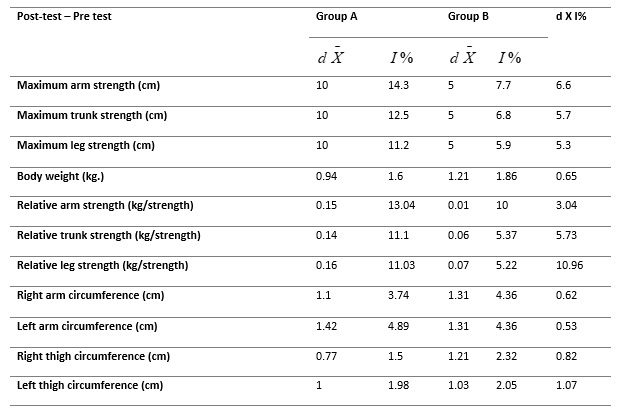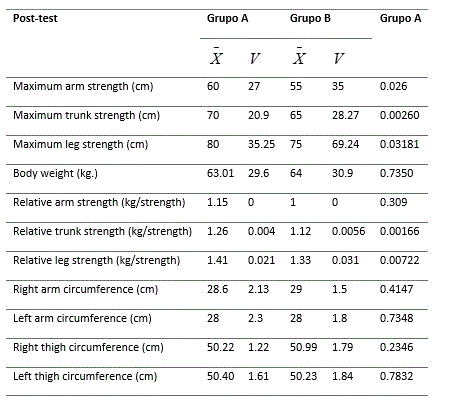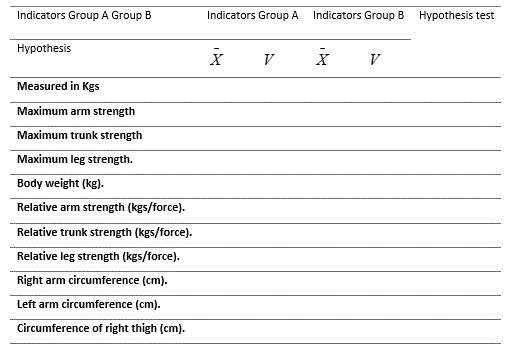My SciELO
Services on Demand
Article
Indicators
-
 Cited by SciELO
Cited by SciELO
Related links
-
 Similars in
SciELO
Similars in
SciELO
Share
Ciencia y Deporte
On-line version ISSN 2223-1773
Ciencia y Deporte vol.7 no.1 Camagüey Jan.-Apr. 2022 Epub Apr 05, 2022
http://dx.doi.org/10.34982/2223.1773.2022.v7.no1.006
Original article
A proposal of strength exercises for long jump athletes of 14- 15 egos
1Universidad de Granma. Campus Blas Roca Calderío, Granma, Cuba.
The present investigation is directed to give solution to a problem which is latent in manzanillo and it is related to the lack of an effective physical preparation in long jump athlets. Therefore, its author attempts to provide a solution to such insufficiency by designing, first and then applying a set of plysical exercises with weights to the schooling - age athletes, in onder to strengthen their physical training, so that they can get higler competitive results. The proposal includes two types of preparation for this sportive modality, the taditional and the proposal provided by the author. The investigation will permit to state criteria about the essential components that play important roles for this sort of physical preparation. This research renders the expected outcomes which will give its author the possibility to apt for the Sport Specialty degree.
Key words: force; preparation; training; performance.
Introduction
Undoubtedly, one of the causes of sports development, since they originated as an organized institution to present, lies in the influence of the different scientific disciplines on sports (Ávila Acosta, R. B.; 2001).
Every year, performance is enhanced in almost all sports activities. These advances are generally attributed to improved opportunities to participate so that individuals with proper conditions will probably be more exposed to particular sports. Better nutrition, medical attention, better athletic equipment, a more systematic and scientific approach to training and sport adjustments also contribute to enhanced performance.
The science-sport relation has made the development of sport possible thanks to the application of science, in the same way science has developed through sports.
Modern Athletics is increasingly influenced by individual principles, permanent collaboration, and reciprocal support among athletes with essential conditions for success.
The efficacy of training depends largely on each athlete’s effort, the condition that each one accepts to use their individual value at the service of performance, and as a way of assessing the efficacy of sports in the results of records and situations, with the purpose of improving competitive results.
Athletics, one of the most universal sports since ancient times, is a discipline based on effort and variable situations. Among others, it characterizes by being in constant change, depending on the situation. Athletes are constantly forced to adapt to new conditions. It depends on the type of competition, the field, weather, opponents, and so on (Anselmi, E.; 1996) .
According to Sánchez, H, Sánchez, A, & Sánchez Oms, Alberto (2021) the greatest percentage of coaches and Physical Education teachers are engaged in the work with adolescents and young athletes across the country as part of the generalization of sports activities. It means that the main link to guarantee that the future of the Cuban sports movement reaches the high-performance pyramid is working with athletes between 12 and 16 years of age. Other authors such as Hernandez, F. A. G. (2014), considers that when using long jump exercises, it is necessary to consider the basic technical principles of the long jump. On the other hand. as it is known the strength quality is very easily gained and lost Garay, B. C., Pujadas, E. A., & Sánchez, G. (2020)., a very important aspect to consider; also (Labrada, S., & Céspedes, J.; 2016) propose exercises that favor the increase of fast leg strength in the jump.
The aim of this research was to design a proposal to enhance the strength of long-jump athletes, considering the reduction in the development of speed-strength capacities of long-jump athletes in the 14-15 year category, which caused a negative impact on their competitive performance during the Provincial Junior Games in the municipality of Manzanillo, province of Granma, Cuba.
Materials and methods
Several different measurements were conducted to determine the indicators of physical development, including a pedagogic test suggested by the Cuban Federation of Athletics, which was applied to assess the influence of combined strength exercises on muscle development of a group of athletes included in the study. This research also relied on measurement and observation methods. Accordingly, a protocol for data collection was designed.
A set of exercises to develop strength of muscle planes
Exercises to develop strength of arm muscle strength
Lying position press: Side-lying position on a bench, the bar rests on the squat stands of the bench or on the athlete’s chest; the feet must be completely on the floor or surface, and the back must be completely on the surface of the bench. It consists in arm extension completely to the chest level. This type of exercise helps develop the extensor muscles of the arms (pectoralis major and minor, triceps), using normal and medium grip bench press.
Standing press training: Standing position, the bar rests on the shoulders of athletes, who raise their arms to complete extension overhead. It uses wide and medium bench press grip, and squat racks. To perform this exercise, the athlete must stay upright, without bending the torso backward, or using the legs during the motion. This exercise strengthens triceps, deltoids, fibers of the upper trapezius, arms, chest, and back, as well as other muscles of the scapular waist.
Exercises to increase trunk muscle strength
Deadlift with extensions: Standing position, the bar rests on the platform or surface. The athlete bends forward, flexing the knees to increase bending, with greater bar displacement. This exercise consists in moving from the initial position to a more erect position, maintaining the trunk upright until the bar is lifted to the waist. This exercise develops the vertebral muscles, the gluteal muscles, quadriceps, and other muscles. It uses combined medium grip bench press.
Trunk torsion in upright standing position: Standing position, the bar rests on the shoulders behind the head. The bar is held by the disc to avoid dropping when trunk turning starts. Torsion is made to both sides, without moving the feet from the normal position. It works on the oblique abdominal muscles, vertebral muscles, and others. The equipment needed is squat racks.
Good morning exercise: The bar rests on the shoulders behind the head; good morning is made by flexing the legs with the trunk bent forward; the exercise ends by extending the legs and trunk, raising the feet from the toe tips. The muscles involved are the back extensors, vertebral muscles, abdominal muscles, and quadriceps.
Exercises to increase leg muscle strength
Back squat: It is one of the most important exercises to develop the leg muscles. Standing position, the bar rests on the shoulders behind the head. The legs in deep flexion with upright back, resting on the soles of the feet. It involves the quadriceps, gluteus, and femoral biceps, mainly. It uses wide and medium grip bench press.
Half squat: The bar stands on the shoulders, the legs are flexed to approximately 90 degrees. It helps develop quadriceps and gluteal muscles, mainly, and also the femoral biceps.
Backward lunges: Standing position, one foot forward flexed on the knee and the front of the foot slightly inward. The back foot extended and resting on the metatarsus with the heel sticking out. The bar rests behind the head, on the shoulders. The front leg is flexed and extended; the same number of repetitions are made with the two legs. Recovery consists of taking half a step backward with the front foot and half step forward with the back foot. This exercise increases leg extensor muscle strength, and the flexibility of the coxal articulation. During the lunges, the front leg withstands a huge load, so legs must alternate. This is a useful exercise, since recovering from the split lunge is difficult. This exercise demands an upright trunk. It uses wide and medium grip bench press, requiring squat racks. This exercise helps develop quadriceps, gluteal, femoral biceps, semi membranosus and semitendinosus muscles, mainly.
Jumping with weights on the back: Standing position, the bar resting on the shoulders (exactly like the previous). It consists of jumping on both legs until the exercise is finished raising from the tips of the toes.
Calf muscle training: The bar rests behind the head. This exercise is done with submaximal and maximal weights, with medium grip bench press. The feet are raised from the tips, then back to normal position. It involves the anterior and posterior tibial soleus, flexor finger muscles, and calcaneus muscles.
Throwing a 1kg object using the two hands from a back position (speed-strength). The athlete stands in a back position in relation to the throwing area, the hands flexed, carrying a metal ball in the hands, the legs, trunk, and arms are extended until the ball is launched backward, overhead, to the throwing area. The distance between the inner border of the throwing circle and the site where the ball hits the ground is measured. Materials: measure tape and a 1kg ball.
Throwing a 1kg object using the two hands to an area in front of the athlete (speedstrength). The subject faces the area, the hands are flexed, carrying a metal ball, the legs, trunk, and arms remain extended until the ball is thrown overhead to the throwing area.
The throwing distance is measured as before. Materials: measure tape and 1kg ball. All the exercises are performed in a quick pace, then they are followed by flexibility exercises to recover by decreasing muscle tension.
The sample chosen comprised all the junior long-jump athletes in the municipality of Manzanillo, aged 14-15. The total subjects included 12 male athletes.
Assessment of the set of exercises to develop strength through the expert opinion method
The level of satisfaction and acceptance of this procedure was assessed by the scientific community in this field of expertise prior to the implementation of this set of exercises to develop strength in junior long-jump athletes, aged 14-15, in the municipality of Manzanillo.
The following aspects were assessed through expert opinion
Theoretical and practical conception of the series of exercises.
Structural and methodological conception of the series of exercises.
Quality and accuracy of guidelines for implementation of the procedure.
Indicators of loads.
Practical satisfaction of the series of exercises.
Correspondence of the set of exercises with the particularities of athlete physical development.
Contribution of the series of exercises to athletic performance Control, of training loads.
I.- Volume:
Sets: It was controlled through the number of continuous repetitions, with rests between sets that were performed throughout the different groups of exercises.
Repetitions: It was controlled through the quantity of lifts made in one set, throughout the different groups of exercises.
Tonnage: It was calculated through the formula suggested by N. I. Luckin (1940) (Equation 1).
II.- Intensity:
Relative mean intensity: It permitted the determination of the percentage representing the mean weight of the maximal weight in the three different types of exercises, and calculated according to: (Equation 2).
Zones of intensity: It permitted the determination of the number of repetitions made by the athletes in the various percentage intervals, in the different groups of exercises worked on during the preparation.
Density: It was calculated through the rest time: It was determined through the time used by the athlete between sets. R. A. Román (1974) said that this time can vary between 2 and 5 minutes, and it depends on the intensity of the load. When working up to 60 % on the zone, resting lasted 2 minutes; 61-70 %, 3 minutes; and 71-80 %, 4 minutes.
Results and discussion
The data collected from the physical development pre-test, Table 1, showed that there were no significant differences among the groups of athletes in the study, which was expressed by the different indicators used to determine the level of initial physical development before the experiment, where p ( 0.01 (Table 1).
Table 2 shows the results achieved during the post-test using the different indicators to measure the level of physical development (Table 2).
When comparing the results of the two groups of athletes in the post-test, all cases were observed to undergo an increase in the maximum strength of the different muscle planes (+5 kg) in favor of group A athletes. In body weight, a 0.99 kg increase was observed in favor of group B athletes.
Regarding relative strength and maximum strength, the best results corresponded to the athletes in group A, showing a 0.15, 0.14, and 0.12 kg/strength increase in the muscles of the arms, trunk, and legs, respectively.
During the measurements of arm and thigh circumference, it was noted that the left limbs showed no differences between the groups, which may be explained by the fact that most athletes are right-handed, and therefore work harder with the right side. The opposite occurred in relation to the right arm and thigh, with a 0.4 and 0.77 cm increase, respectively, in favor of athletes in group B. An analysis of the significance levels of the results between the groups in terms of maximum strength and relative strength of different muscle planes, significance of these indicators was higher in the athletes in group A, where p > 0.01. Meanwhile, in the body weight and arm and thigh circumference indicators no significant differences were observed between them, since p ( 0.01.
The reason for this is that during this stage of preparation, the athletes in the research did not use heavy load volumes, resulting in insignificant increases of muscle hypertrophy in the limbs of the athletes in the study.
An assessment of the mean difference (d X ) and the increase percent (I%) of the indicators used for the pre-test of physical development (Table 3) showed that the athletes in group A underwent a +10 kg increase of maximum strength of the different muscle planes, with the highest increase associated with the strength exercises in a lying position (14.3 %), followed by deadlift exercises with flexions (12.5 %), and the back squat exercises (11.2 %) (Table 3).
Table 3 - Mean difference and increase percent between the post-test and the pretest if the indicators used to measure physical development

Just like in maximum strength, the best results regarding the mean difference and percent increase of the relative strength of different muscle planes corresponded to athletes in group A, with a 0.15 kg/strength increase in the arm muscles (13.04 %); followed by the legs, with 0.16 kg/strength (11.03 %); and finally, the trunk, with 0.14 (11.1 %).
The arm and thigh circumferences evidenced little increase in the athletes in group B, which behaved as follows: right arm circumference increase of 1.31 cm (4.36 %); right thigh, accounting for 1.21 cm increase (2.32 %); left thigh, with 1.03 cm (2.05 %). The highest increase of the circumference of the left arm was observed in group A athletes, with 1.42 cm (4.89 %).
Conclusions
The selection of strength exercises shows the validity of using weight exercises, in theory due to the advantages it offers to strength training optimization. Its application in practice produced 99.9% reliability.
The physical development of junior long-jump athletes, aged 14-15 in the municipality of Manzanillo, Granma province, Cuba, shows poor maximum strength development in relation to body weight, and the arm and thigh circumferences, which led to a decrease in the indexes of relative strength and speed strength of different muscle planes evaluated in the pre-test, though this series of exercises demonstrated the results of the hypothesis test, with p>0.01.
The combination of exercises for strength training in this athlete category differs from the traditional training. The main principle is not to use large volumes of repetitions and intensity percentages (IRM), where the highest work percentage is accomplished during the first two weeks, with a gradual decrease of repetitions in the last two weeks before the main competition, whereas the mean intensity tends to increase as the competition nears, varying between 75 and 80 % IRM.
The purpose of this research was met thanks to the implementation of the exercises suggested, whose outcome permitted the corroboration of the research hypothesis (Table 4).
Annexes
Referencias bibliográficas
Anselmi, E. H. C. (1996). Fuerza y potencia. La formula del éxito. Edición del Autor. ISBN 978-950-43-7504-3 https://es.slideshare.net/coloradovastell/libro-manual-de-fuerza-potencia-y-acondicionamiento-fsico-e-anselmisigned [ Links ]
Ávila Acosta, R. B. (2001). Metodología de la investigación. Estudios. Ediciones R.A. [ Links ]
Garay, B. C., Pujadas, E. A., & Sánchez, G. (2020). Comportamiento de la potencia anaeróbia alactácida en las diferentes divisiones de pesas en la etapa especial.Revista Cubana de Medicina del Deporte y la Cultura Física, 4(3). http://www.revmedep.sld.cu/index.php/medep/article/view/358 [ Links ]
Hernández, F. A. G. (2014). Resumen de salto de longitud.Vida Científica Boletín Científico de la Escuela Preparatoria No. 4, 2(3). https://www.uaeh.edu.mx/scige/boletin/prepa4/n3/m2.html [ Links ]
Labrada, S. J. J., & Céspedes, J. M. J. (2016). Programa de ejercicios pliométricos para mejorar el salto de las lanzadoras de softball de la categoría juvenil.Revista científica OLIMPIA,13(39), 25-36. https://dialnet.unirioja.es/servlet/articulo?codigo=6210554 [ Links ]
Sánchez Acosta, Hiramnia M., Sánchez Acosta, A. & Sánchez Oms, A. B. (2021). Procedimiento metodológico para la determinación de las invariantes de habilidades motrices del salto de longitud en la iniciación deportiva.Podium. Revista de Ciencia y Tecnología en la Cultura Física,16(1), 275-290. http://scielo.sld.cu/scielo.php?script=sci_arttext&pid=S1996-24522021000100275 [ Links ]
Received: September 29, 2021; Accepted: October 13, 2021











 text in
text in 







